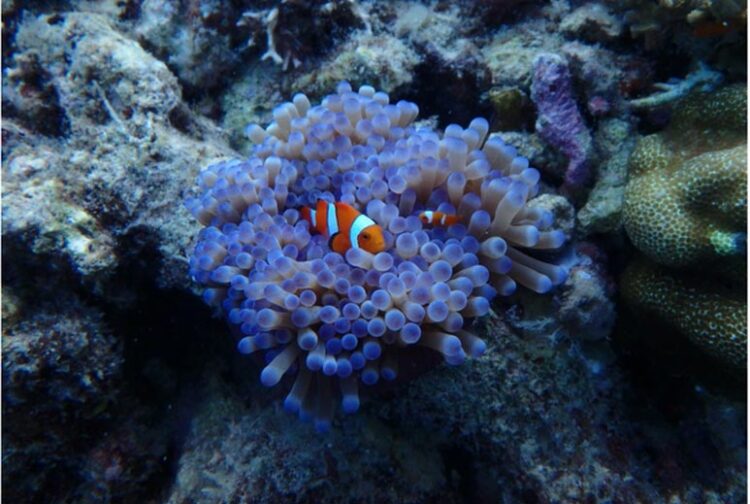How nemo fits in his anemone

Clown anemonefish
Credit: Dr Theresa Rueger
Study reveals how clown anemonefish adjust their growth to their environments.
Research has shown how clown anemonefish control their growth to match the size of their anemone host.
Scientists from Newcastle and Boston Universities investigated the relationship between the size of the fish and the size of the anemone by pairing clown anemonefish with anemones of various sizes in a series of lab experiments. They found that that fish on larger anemones grow faster than fish on smaller anemones.
The results offer the first experimental evidence that vertebrate growth plasticity responds to a mutualistic interaction (where both partners benefit) and explain why anemonefish size and anemone size are so closely correlated in the wild.
Publishing their findings in the journal Scientific Reports, the researchers argue that by adjusting their growth, anemonefish likely maximize their reproductive value given their anemone context.
The team rule out food availability and space availability by itself as possible mechanisms. One possible explanation is that space availability together with a biological cue from the mutualistic host are responsible for the pattern. The precise mechanism behind the phenomenon will be the topic of future investigations.
Lead author, Dr Theresa Rueger, Lecturer in Tropical Marine Biology at Newcastle University’s School of Natural and Environmental Sciences, said: “Anemonefishes are fascinating for their ability to adjust their growth rate to their specific environments, whether that’s to avoid conflict with a larger fish or, as we show here, to make sure they are the ideal size for their anemones.
“Anemones are important for the fish because they provide protection from predators and the larger the anemone, the more space the fish has to move around and feed while still being save. If the fish would get too big for the anemone it is on, it might not get enough food or be safe. At the same time the fish wants to be as big as possible to be able to produce lots of offspring.
“Our data from wild fish shows that anemone size and fish size is very closely correlated: large fish are always on large anemones. And our experiment shows that is not a coincidence but the fish actively regulate their growth to fit their anemone host. This is the first time that this plasticity of growth in a vertebrate has been found to depend on a mutualistic partner, and it shows how important mutualisms are.
“The next step will be to disentangle the mechanism, what makes the fish decide how large it needs to be? Through our experiment we already know it’s not food availability (all fish got the same amount of food) and it is not space availability alone (the fish did not show the same plasticity when they were on silicone anemones), so it seems to be something about the mutualistic partner itself. Lots of research still to be done!”
The ability to anticipate the ideal body size in relation to the mutualistic partner is most likely present in other mutualistic relationships. Future research will focus on investigating the interplay of mutualistic partners and the effect on animal growth regulation and developmental phenotypic plasticity.
Journal: Scientific Reports
Method of Research: Experimental study
Subject of Research: Animals
Article Title: Vertebrate growth plasticity in response to variation in a mutualistic interaction
Article Publication Date: 18-Jul-2022
Media Contact
Ivan Lazarov
Newcastle University
ivan.lazarov@ncl.ac.uk
Office: 07-927-369-951
All latest news from the category: Life Sciences and Chemistry
Articles and reports from the Life Sciences and chemistry area deal with applied and basic research into modern biology, chemistry and human medicine.
Valuable information can be found on a range of life sciences fields including bacteriology, biochemistry, bionics, bioinformatics, biophysics, biotechnology, genetics, geobotany, human biology, marine biology, microbiology, molecular biology, cellular biology, zoology, bioinorganic chemistry, microchemistry and environmental chemistry.
Newest articles

Sea slugs inspire highly stretchable biomedical sensor
USC Viterbi School of Engineering researcher Hangbo Zhao presents findings on highly stretchable and customizable microneedles for application in fields including neuroscience, tissue engineering, and wearable bioelectronics. The revolution in…

Twisting and binding matter waves with photons in a cavity
Precisely measuring the energy states of individual atoms has been a historical challenge for physicists due to atomic recoil. When an atom interacts with a photon, the atom “recoils” in…

Nanotubes, nanoparticles, and antibodies detect tiny amounts of fentanyl
New sensor is six orders of magnitude more sensitive than the next best thing. A research team at Pitt led by Alexander Star, a chemistry professor in the Kenneth P. Dietrich…





















